Note
😂😂😂😂😂😂
you're a stupid fucking anti-sjw lol. This blog is stupid. I hate you crackers white people SUCK go suck a dick.
looks like I triggered more sjws. Keep sending these asks they only fuel my logic.

268K notes
·
View notes
Note
Could i please get a small mammal cursed bio fact if u have one
the grasshopper mouse of the southwestern United States looks like a standard house mouse but is almost entirely carnivorous and is known to kill and consume everything from less homicidal mice to goddamn rattlesnakes, which they kill by jumping onto the snake’s back and gnawing through its spine
118K notes
·
View notes
Photo
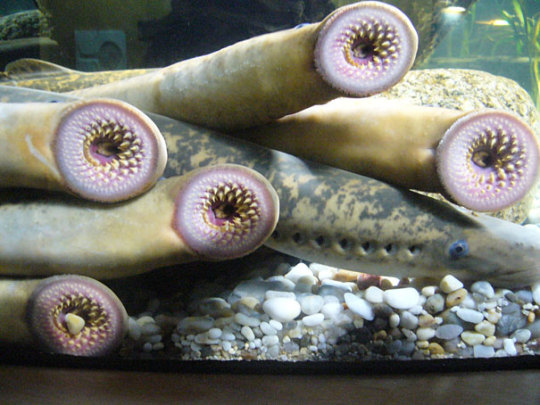



Sea lampreys are parasitic fish native to the Atlantic Ocean. Sea lampreys, which parasitize other fish by sucking their blood and other body fluids, have remained largely unchanged for more than 340 million years and have survived through at least four major extinction events.
Sea lampreys are unique from many other fishes in that they do not have jaws or other bony structures, and instead possess a skeleton made of cartilage. While sea lampreys resemble eels, they are not related and are set apart by their unique mouth: a large oral sucking disk filled with sharp, horn-shaped teeth surrounding a razorsharp rasping tongue. (Source)
11K notes
·
View notes
Text
😂😂😂😂😂
i raise you comic artists who can’t draw kids and offer you comic artists who absolutely cannot draw babies
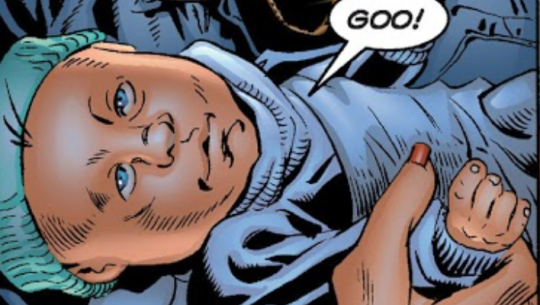
127K notes
·
View notes
Text
African Textiles....Real Ones
One of the benefits of living and working at the the Nike Centers For Art and Culture is that I get a chance to document her incredibly extensive textile collection. The collection includes Nigerian Textiles (mostly from the Yoruba kingdoms), Raffia cloths from the Kuba federation in the Democratic Republic of Congo. Malian “Bogolanfini” Mud cloths and even one beautiful example of of a Ghanaian Kente cloth. The Yoruba made textiles are by far the most extensive part of the collection and include cloths made on both the Women’s (vertical) and Men’s (horizontal, narrow strip) looms. The collection also includes a huge variety Adire (tie and dye and starch resist ) cloths executed on both handwoven and machine woven cloths. The woven textiles include antique textiles woven with hand spun cotton threads, dyed with natural dyes (Mostly indigo with some some camwood dyed warp sections). They also include “Sanyan” textiles woven with the once illustrious beige wild silk collected from the indigenous anaphe moth, as well as textiles woven with imported silks from Asia and synthetic and machine spun cotton, rayon and polyester threads from Europe, Asia and the Americas. There were Indigo robes, shirts, trousers, wrappers and hats. The textiles beauty is only surpassed by their diversity. The pieces are testaments to tradition as well as ingenuity and creativity. There are clothes that could have easily been worn in the ancient courts of Ile Ife and the Ogiso era Benin Kingdom and others that take ancient motifs and execute them with brilliant synthetic or metallic threads, sometimes sewn together with imported textiles to create beautiful and unique pieces speaking to the individuality of the weavers. I began to respect the creators not only as traditional craftsmen, but as contemporary textile artists, working from an African aesthetic tradition.
Below: Examples of textiles using hand spun, hand dyed silk (Sanyan) and cotton threads, as well as machine spun imported threads in imitation of natural dyed threads. The colors and patters used in the AsoOke (Narrow strip cloths) are similar to those created since at least the 16th century, While the striped indigo Women’s loom AsoOfi echo back to cloths made in southern Nigeria dating back the 9th century.

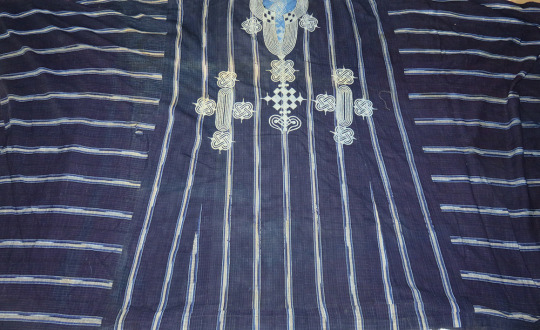

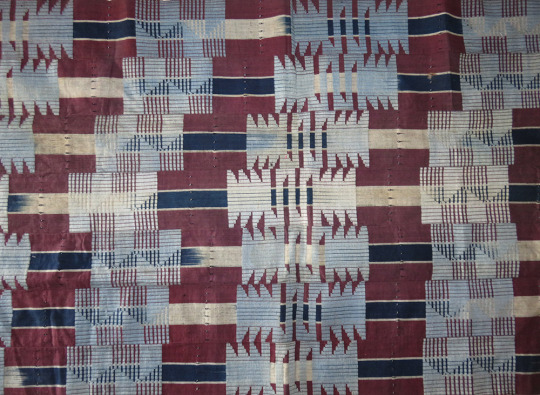

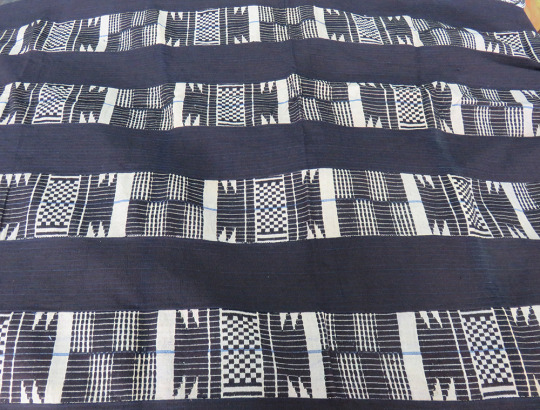

Below are examples of Adire textiles. The top two are representative of the Adire Eleko ( Cassava Starch Resist) techniques developed by Yoruba Women in the early 20th century. Below them are Examples of Adire Oniko (Tie and Dyed) on Kijipa (Hand woven cotton cloth using hand spun threads on a Women’s vertical loom). The textiles make use of the “Eleso/fruits” and “Osupa/moon” patterns. Textiles such as these were made as far back as the 11th century.
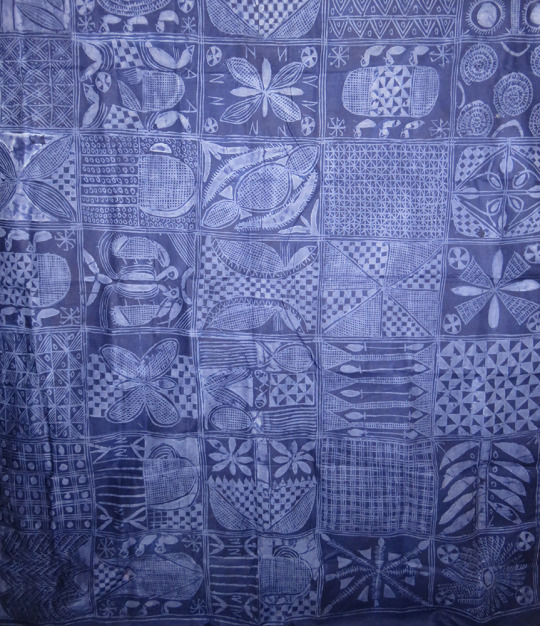


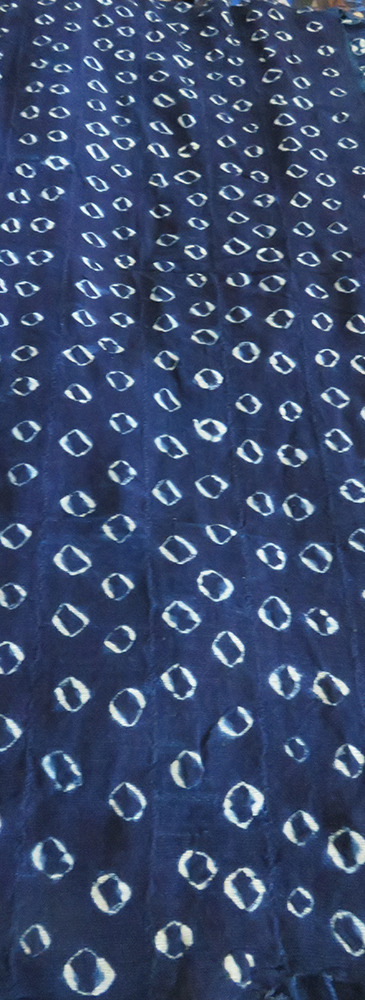

Below are some example of Chief Nike Okundaye’s extensive Raffia Textile collection.

A minimalist example of Malian Bogolanfini “Mudcloth”

A more contemporary handwoven Dashiki made using handwoven AsoOke “stripwoven” Fabric and machine embroidery. The basic style in format though is quite old.
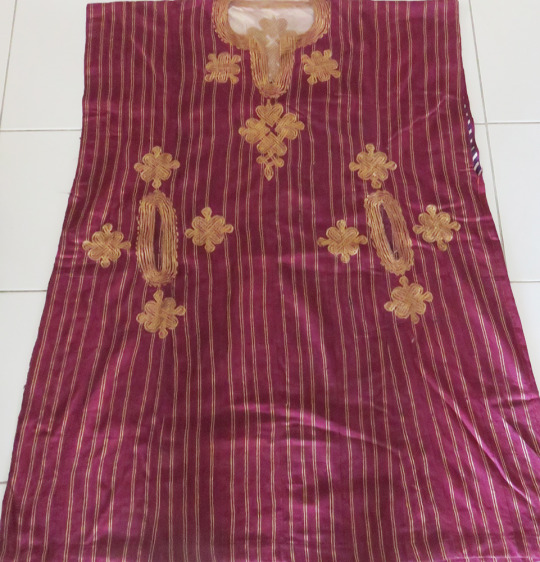
A unique cloth that incorporates machine woven Damask fabric with hand woven AsoOke, utilizing “Jawu/openwork” and metallic threads.

Being immersed in this tradition made me think about the perception African textiles in the Americas. For so many Dutch, Indian or Chinese made printed textiles have become synonymous with African cloths. These wax prints although an important part of contemporary African Identity often undercut the rich local handmade textile traditions of west and central Africa. The ancestral resist dyeing and weaving traditions that link Africa with diaspora often go unnoticed in favor of the printed textiles, as do important avenues of mutual exchange and economic development of African creative markets. The “invasion” of these foreign textiles is so absolute that they have almost completely replaced the once vibrant raffia weaving tradition of central Africa, which at one time was producing tens thousands of yards of domestic and luxury textiles. These “Wax Print” textiles were originally created by the Dutch to sell in Indonesian markets were often made to specifically imitate the Batik patterns and motifs of southeast Asia. When it was discovered that these cloths sold far better in African markets they began exporting them across the continent. Although these early 20th century Africans loved these brightly colored “new “textiles, their patterns and colorways held little to no significance to the preexisting textile traditions and at least in West African indigenous weaving and resist dyeing traditions continued to flourish and evolve alongside these newer imports. For us in the Diaspora it important to understand that our ancestors would not be able to recognize brightly colored machine made textiles that we associate with Africa now. What we call a dashiki is vastly different from the ones they wore, but also very similar to those made in West Africa today by West African weavers and tailors, who maintain these vibrant traditions. The technicolor floral and kaleidoscope patterns that dominate printed textiles would have also been alien to them, but the tie and dyed patterns that are still made and used in Nigeria, Mali and Liberia would have been strikingly familiar, as they not only predate the transatlantic slave trade, but may have been practiced by the descendants of African slaves in the Americas up until the 19th century.
Below: Pre 20th century robes: Top: Kanuri robe from the mid 19th century embroidery on imported silk. Second: Mande robe from the 17th century indigo dyed robe with tie dyed “eleso” pattern. Third: mid 19th century embroidered Dahomean robe from what is now the Republic of Benin, Strip woven fabric with embroidery. Fourth: 17th century strip woven tunic most likely from a Mande speaking region.




The indigenous textile traditions of Africa are rich and varied, and represent both continuity and change. As we in the diaspora begin to explore African textiles it is important that we understand the roots of these traditions and the fascinating ways in which these aesthetics and traditions relate to our own textile and aesthetic traditions and how we can economically support this incredible work made by black artisans.
199 notes
·
View notes
Text
Fan fictionnnnn
Wanna publish some Planet of the Apes and Jurassic World crossover fan fiction. Only problem is I'm going through it right now and writing anything of quality just seems really impossible. Had a burst of creativity for like 3 weeks and now the crash has taken me to depths I thought I'd climbed out of months ago. Do I need more sunlight? Less social media? Combination of the two? Maybe.
#writers block#depression and writing#writers of color#writer's block#black and blue#going through it alone#self worth on hold#black sheep
1 note
·
View note
Text

Just surviving.
Just doing what I can to stay sane in this ephemeral avatar that I'm in. Hated. Degraded. Whatever else they can think to do. Still get up each day looking forward to the chatter of the birds at my window. Loving my family and friends as best I can with what's left of my capacity to feel outside of REM sleep.
Just doing what I can to keep my head above the water. I'm not doing my best. Hell, I barely have the will to do so. But it's something, to still breathe.
I'm just too grateful to still be alive, to have made it to 2020 alive. That's really all that matters. I just hope the future will look better for my fellow misfits, black sheep, underdogs, survivors, kin, near and far around the globe. That's really all.
#keep your head up#hang in there#it's okay to feel#are you ok?#talk it out#write it out#no shame in honesty#survivor#surviving animus#being the other#being the outsider#no matter what we do they still have something to say
1 note
·
View note
Text
Authors are not responsible for the creepy fan-fiction dreams of their readers.
who the FUCK told society that depression and awkwardness is cute and adorable
622K notes
·
View notes
Photo
I.....I love you
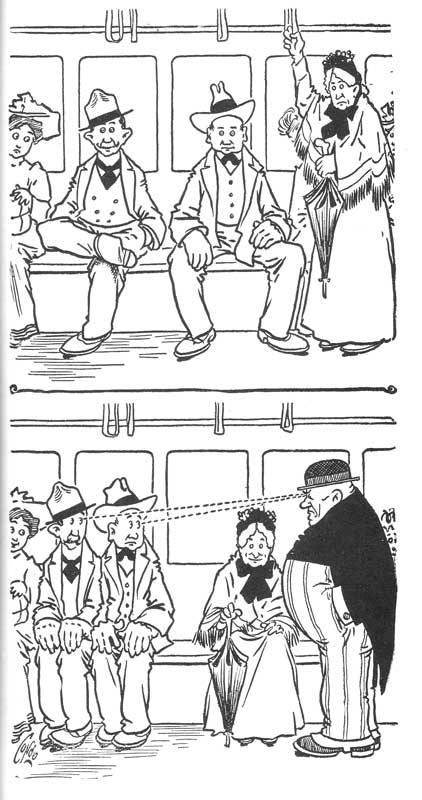
The Outbursts of Everett True was a comic strip that ran in papers from 1905 to 1927, wherein the aforementioned Everett True regularly beat the everliving shit out of rude people as a warning to anyone else who might consider being rude. Men have not only been taking up too much room on public transport for about as long as public transport has existed, but the people around them have been irritated about it for at least a hundred years. The next time someone tries to claim that manspreading is a false phenomenon, please direct them to this strip so that Everett True can correct their misconceptions with an umbrella upside the head.
504K notes
·
View notes
Text
This is the hardest time of year, and if you are grieving, if you are lonely, if you are financially strapped know that you are not alone. You are so important and you may not see it, but you are loved by someone. Don’t hesitate to reach out to others; you never know who will reach back. Please take care of yourself this holiday season, and if you can, be there for others who could use some love too.
23K notes
·
View notes
Text
Wh---
god i remembered that fucking “little white cuck ball” picture and im cackling
101K notes
·
View notes
Photo

The photo above is the closest humanity has ever come to creating Medusa. If you were to look at this, you would die instantly.
The image is of a reactor core lava formation in the basement of the Chernobyl nuclear plant. It’s called the Elephant’s Foot and weighs hundreds of tons, but is only a couple meters across.
Oh, and regarding the Medusa thing, this picture was taken through a mirror around the corner of the hallway. Because the wheeled camera they sent up to take pictures of it was destroyed by the radiation. The Elephant’s Foot is almost as if it is a living creature.
291K notes
·
View notes
Photo
Can't get past somebody else remembering Animorphs 😂

jeez spoilers rey is a friggin’ animorph
91K notes
·
View notes
Text
Tumblr, I'm going to need you guys to tear this malicious liar a new one because the sheer magnitude of outright fantasies, misinformation and fabrications is too much for me to tackle tonight.
But let's start with the contradictions.
According to this badly written racist/ableist gunk:
1. All Neurodiverse people are Eurasian because Eurasians are mixed with Neanderthal (yet strangely enough, they conveniently leave out Aboriginals of Australia..... which blows up their entire disorganized theory about autism prevalence being directly linked to non-Africanness). South African San must be Eurasian cause "looks uwu".... but not neurodiverse? No info was given to back up this bizarre fallacy based on supposed visual similarities. It also never mentions any prevalence of autism among southeast Asians or Aboriginal Australians who are more Asian even than the San and even Berbers.... wtf.
2.Neurodiverse people (primarily Eurasian) can communicate telepathically and are more likely to believe in ghosts than neurotypicals (says who? This completely throws off the rest of the bizarre article, because most societies that are advanced and make "complex musical instruments" (lmao) move closer towards atheism and belief in scientific explanation for strange phenomena). And if that is the case, why then do Africans, who according to this creepy article, have the least cases of autism, have the highest number of spiritualists (statistics show that Africans are extremely religious and superstitious across various countries) in the modern world? Fewest number of atheists by observation (same way the writers makes the assumption that African MUSIC was purely for "entertainment" and not "complex". This person did NO research whatsoever before writing this fantasy story). And how do you use random surveys and opinions as citations?
Okay folks, please be careful where you get your info from. Especially written by a mentally deranged person arguing in favor of "de-pathologizing" serious illnesses like schizophrenia while promoting some of the most insidious racism I have ever seen online. They go back and forth between racist masturbations, delusion, opinion stated as fact and denial of legitimate scientific findings.
For example, their timelines for the migrations and origins of different homo type species were all over the place. They also mentioned primates that have nothing to do with humans or neanderthals. For like no reason. A waste. And then talked about ransom animals.
Also, how would hunter gatherers who have not advanced passed bows and arrows (the San) have introduced cattleherding to pastoralists who smelt iron, have actual kingdoms (also leaving behind brick structures and gold figures as is the case with Great Zimbabwe) and militaries (the Nguni)??????
The constant worship of the San while denigrating the Nguni/Bantu, Sahelian, Igboid etc groups sounds like a racial fantasy cooked up solely for the purpose of expressing animus towards Greater Africans, since no links to neurodiversity and neanderthals was made to these hunter gatherer San people.
If anything this outlandish piece of internet bottom scrapings further validates the pathologization of the very neurological conditions it seeks to vindicate, because it all sounds like word salad or a dangerous racist manifesto based purely on the limited scope and internal ramblings of a person who has trouble obtaining basic information for a thesis. Disorganized, detached and hallucinatory.
Can we also not lump all neurodiverse conditions into one basket? Some people are REALLY suffering from severe autism, ADHD and schizophrenia. This article completely erases that experience and instead puts forth a jumbled and sloppy smorgasbord of random ideas that do not actually support the thesis presented.
And one cannot take arbitrary percentages and link them together to prove a point. If people who score INFP/INFJ/etc on MBTI tests are 10% of the population, it doesn't mean that other groups (neurodiverse) that are only 10% of the population are "linked". This article went on to say ADHD was normal because introverts, essentially.
What?
#faux anthropology#fake anthropology#neanderthal theory#neanderthals and autism#autism an atavism?#autism atavism#internet hoax#racism#schizophrenic word salad#word salad#asian origin theory#origin of homo sapiens#fiction presented as fact#poc please interact#poc interact#afrophobia#negrophobia#afrophobic writing#autism pathology#schizophrenia pathology#neurodiversity origins#neurodiveristy#tw racial violence#tw racism#tw afrophobia#tw anti blackness
1 note
·
View note


